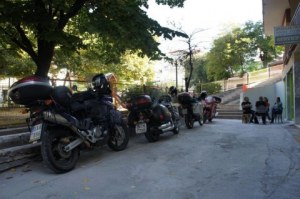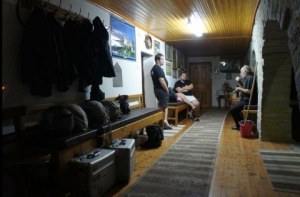It had been about 6 months since my last visit to Kozani. Keepng my promise to Mimis and Sakis A., I decided to visit them again before the cold started. The date was set for Wednesday, 26th of September, with the purpose of biking around the area. Due to some problems and obligations that came up, we finally first managed to leave on Friday. The same day, Achilleas would come (from Thessaloniki), Giorgos Z. (from Nauplio) and Stratos (from Athens). The first meeting of biking groups MotoRiders and Motodiadromes was a fact!!!
Sakis A and Mimis know their area very well. Especially Sakis A bikes around in his spare time, discovering hidden beauties, while feeding his great passion: photography! I think myself lucky to have had the opportunity to discover the area with them on my side.
So, we started from Kozani with our initial destination being Aiani (20 km), which was near the aritificial lake of Aliakmon (6 km). The -seemingly- uninteresting village has a notable archaeological museum. It is recently built and it houses an impressive collection from the area of the ancient “Upper Macedonia”. The archaeological digs in the area have revealed hidden “treasures” dating back to the Neolithic era. Utensils, pots, weapons, jewelry and figurines are only some of the impressive findings, many of which are unique (!) even internationally!!!
We were really lucky, as Petros, an employee of the museum (entrance fee: 3€), was a friend of the guys and he gave us a really nice tour. Although he was not an archaeologist, he knew a great deal of things, which helped us understand and focus on things that would probably go unnoticed if he didn’t. By speaking with him we understood his taste and passion about the findings. May he be well and many others to follow his example! Unfortunately, the position of the museum does not help with the publicity of its collection of “treasures”. What is certain is that it is well worth it and someone who is in the area should visit it.
We left Aiani, moved for 5-6 km and reached the bridge that connects the two banks of the Aliakmon Lake. This area is the valley on which the southwestern part of the lake is. Currently, there is an expansion program on course on behalf of the Public Power Corporation of Greece. We stopped to admire the landscape! We had the chance to see many types of birds, as the area is a passing.
After the bridge we turned right, towards the old asbestos factory. The road moved on a spiral through undergrowth, and gave many opportunities for a spectacular, panoramic view of the whole area. After about 10 km we reached the factory, which has not worked for many years. People in charge have started a process of withdrawal of the machinery and bringing down the buildings. This is done by a specific procedure, as the asbestos is harmful –sometimes carcinogenic- for humans. We saw the buildings from afar, while some employees warned us not to get closer to the area.
From that point, a road started that extended for 3-4 km and ended up to the village Mikrovalto. We followed it and continued towards Tranovalto. Soon we reached the crossroads to Boucharia. We turned left and road on a very beautiful route for 6-7 km. We ended up in front of the wooden house where the beginning a small stone road was so we left the bikes there and started on foot to visit the sight.
It is a geological park. The name most probably comes from the word “bouchari” which means “chimney”. The locals name the formations in a variety of ways, including “the chimneys of the witches”, “the ladies with the umbrellas”, “the gorges of the unsleeping giants and faeries”, “the ddemons’ gorge”. In reality, they are natural formations created by corrosion during thousands of years. They have the shape of a pillar made of gravel and are made of sand, stones, marls and clay probably “glued” together by iron oxides and silicon dioxide. The top of the formations is covered by a plate of spalte that played the role if the “umbrella” during their creation. The result is impressive!!!
The artificial stone roads lead to several observation decks, which gave us the change to admire this unique landscape. Unfortunately, the area has not gained the focus it should have and thus the only visitors are locals. It is something excellent, though, and the best time to visit is in the afternoon, when the setting light highlights its charm!
We left Boucharia and started for the Venetikos river bridge. (64 km) which is a few kilometres before Grevena (on the highway connection Kalampaka and Grevena). The road, on its majority, crossed an area with much vegetation. We stopped for a few minutes at the point where the road comes close to the Zavorda monastery. It is on a tall and very steep rock whose foot the river Aliakmonas crosses. Because of the extension program of the lake with the same name, the area will be flooded, making the monastery look like it is on an island!!! This may be a good reason for us to visit the area once more in the future.
Reaching the Kalabaka-Grevena road (40 km), we took a right turn and entered an area with even more vegetation. Tall trees and a road with many comfortable turn led us to the bridge of the Venetikos river. That spot does not go unnoticed by people passing by. The carved tall rocks –which remind the ones in Meteora- and the river contribute to an astonishing result. We stopped to rest, enjoy the view and contact Achilleas, who had reached Grevena and was waiting for us to continue our trip together.
We started for Grevena and rode for about 15 km. In a cafe in the center of the town, Achilleas was waiting for us. After everyone met everybody we sat to rest and discuss the next steps of the trip. Achilleas is from Krimini, one of the villages of Voio. Knowing the region very well, along with the others from Kozani, they planned the route to the Aghia Triada monastery (80 km), where we would spend the night.
The road to Krimini (30 km) was passing through an overgrown area. The comfortable turns made the ride enjoyable. We came across very few vehicles during most of the way. We reached an altitude of 1000 m. At many palces we had a great panoramic view of the mountains. The villages we found along the way were well kept, using the traditional stone architecture of the area.
We reached Rodochori and a little later we ended up in the cetral square of Krimini. These two villages are very different from the other ones in Voio. You would think they came out of a fairytale. Especially Krimini is more scenic and quiet, with beautiful, well-kept stone houses. In its center, there is the imposing church of Agios Eustathios, in the shade of 2-3 huge platanuses. Thick vegetation, mansions with flowery yards, narrow streets and an old othoman fountain are some of its characteristics.
We stopped for a spell and Achilleas, full of pride, gave us a tour, mentioning stories from the village and moments from his childhood. We walked through the narrow streets discovering beautiful corners. After some time we left and started towards Tsotyli (11 km). When awe exited we crossed a small stone bridge that connected the banks of the small river Pramoritsas.
Late in the evening we reached Tsotyli which is on the old higheay which connects Kozani and Ioannina. We bought some food and left towards Ioannina and especially Pentalofos (30 km). We contacted Giorgos Z and Stratos, who were in Neapoli and were moving towards our destination as well. Since it was already night, we could not enjoy the route, so we made haste and around 8 pm we reached Pentalofos.
There it was where and Sakis A and I decided to go to the Aghia Triada monastery (9 km) while the rest would stay and wait for the others who were some kilometers away. We didn’t want to delay, since father Serafim was waiting for us. Saik A had arranged for us to spend the night inside the monastery and it wouldn’t be polite to make him wait. Following a narrow road through Vythos, we managed to gather at the monastery by 8:30 pm.
Father Serafim welcomed us with his distinctive modesty. He had a room with 6 beds ready for us. We arranged our stuff and went down to the kitchen to rest and prepare some food. The monk made us feel like home, proving –once more- how worldly he is. At around 11 pm we all sat in the kitchen to eat, while the father kept us company. Once we had finished with our food we cleaned up and started discussing about the monastery and its history.
Briefly it goes like this: The monastery on its current position was founded in 1792, near the older monastery of Taxiarches, the Palaiomonastiro (Old monastery). The temple, build with hewn stone, it is a great example of the architectural tradition of Voio and is well known for its unique Otto style main area and its magnificent wall painitngs. It is build in Byazntine order with three domes, a beautiful carved wood templon and very amazing wall paintings. The whole building that supports it is very imposing and can host 100 people. Today, the mainstay of the monastery is father Serafim, a very hard working and pious man, who takes care of the monastery with much dedication. He is from Anthousa, also in Voio, meek, good and always very helpful.
The monastery was challenges with abandonment and destruction but managed to stand its ground, fought back, resurrected and is once again standing proud of its glorious past, willing to offer its hospitality and grace to anyone who asks for it. For most of us, it was the first time to stay in a monastery, gaining the best and most positive of impressions. Regardless of our beliefs, we all felt the calm and quiet that the place and –mostly- the monk emit. We thank him for his hospitality and we hope more people simulate his work and character.




















